Baum Lyman Frank

Lyman Frank Baum (May 15, 1856 – May 6, 1919) was an American author, poet, playwright, actor and independent filmmaker, best known today as the creator, along with illustrator W. W. Denslow, of one of the most popular books in American children's literature, The Wonderful Wizard of Oz. He wrote thirteen sequels, nine other fantasy novels, and a plethora of other works (55 novels in total (plus four "lost" novels), 82 short stories, over 200 poems, an unknown number of scripts, and many miscellaneous writings), and made numerous attempts to bring his works to the stage and screen. His works predicted such century-later commonplaces as color television, laptop computers (The Master Key), wireless telephones (Tik-Tok of Oz), and the ubiquity of advertising on clothing (Aunt Jane's Nieces at Work). Baum was born in Chittenango, New York in 1856, into a devout Methodist family of German (paternal line) and Scots-Irish (maternal line) origin, the seventh of nine children born to Cynthia Stanton and Benjamin Ward Baum, only five of whom survived into adulthood.[1] He was named "Lyman" after his father's brother, but always disliked this name, and preferred to go by his middle name, "Frank".[2] His mother, Cynthia Stanton, was a direct descendant of Thomas Stanton, one of the four Founders of what is now Stonington, Connecticut. Benjamin Baum was a wealthy businessman, originally a barrel maker, who had made his fortune in the oil fields of Pennsylvania. Baum grew up on his parents' expansive estate, Rose Lawn, which he always remembered fondly as a sort of paradise.[3] As a young child, he was tutored at home with his siblings, but at the age of 12 he was sent to study at Peekskill Military Academy. He was a sickly child given to daydreaming, and his parents may have thought he needed toughening up. But after two utterly miserable years at the military academy, he was allowed to return home.[4] Frank Joslyn Baum, in his biography, To Please a Child, claimed that this was following an incident described as a heart attack, though there is no contemporary evidence of this (and much evidence that material in Frank J.'s biography was fabricated). Baum started writing at an early age, perhaps due to an early fascination with printing. His father bought him a cheap printing press, and he used it to produce The Rose Lawn Home Journal with the help of his younger brother, Henry (Harry) Clay Baum, with whom he had always been close. The brothers published several issues of the journal and included advertisements they may have sold. By the time he was 17, Baum had established a second amateur journal, The Stamp Collector, printed an 11-page pamphlet called Baum's Complete Stamp Dealers' Directory, and started a stamp dealership with his friends.[5] At the age of 20, Baum took on a new vocation: the breeding of fancy poultry, which was a national craze at the time. He specialized in raising a particular breed of fowl, the Hamburg (chicken). In 1880 he established a monthly trade journal, The Poultry Record, and in 1886, when Baum was 30 years old, his first book was published: The Book of the Hamburgs: A Brief Treatise upon the Mating, Rearing, and Management of the Different Varieties of Hamburgs.[6] At about the same time, Baum embarked upon his lifetime infatuation with the theater,[7] a devotion which would repeatedly lead him to failure and near-bankruptcy. His first such failure occurred when a local theatrical company duped him into replenishing their stock of costumes, with the promise of leading roles that never came his way. Disillusioned, Baum left the theatre—temporarily—and went to work as a clerk in his brother-in-law's dry goods company in Syracuse. At one point, he found another clerk locked in a store room dead, an apparent suicide. This incident appears to have inspired his locked room story, "The Suicide of Kiaros", first published in the literary journal, The White Elephant. Yet Baum could never stay away from the stage long. He continued to take roles in plays, performing under the stage names of Louis F. Baum and George Brooks. In 1880, his father built him a theatre in Richburg, New York, and Baum set about writing plays and gathering a company to act in them. The Maid of Arran, a melodrama with songs based on William Black's novel A Princess of Thule, proved a modest success. Baum not only wrote the play but composed songs for it (making it a prototypical musical, as its songs relate to the narrative), and acted in the leading role. His aunt, Katharine Gray, played his character's aunt. She was the founder of Syracuse Oratory School, and Baum advertised his services in her catalog to teach theatre, including stage business, playwriting, directing, and translating (French, German, and Italian), revision, and operettas, though he was not employed to do so. On November 9, 1882, Baum married Maud Gage, a daughter of Matilda Joslyn Gage, a famous women's suffrage and radical feminist activist. While Baum was touring with The Maid of Arran, the theatre in Richburg caught fire during a production of Baum's ironically-titled parlor drama, Matches, and destroyed not only the theatre, but the only known copies of many of Baum's scripts, including Matches, as well as costumes and props. In July 1888, Baum and his wife moved to Aberdeen, Dakota Territory, where he opened a store, "Baum's Bazaar". His habit of giving out wares on credit led to the eventual bankrupting of the store,[8] so Baum turned to editing a local newspaper, The Aberdeen Saturday Pioneer, where he wrote a column, Our Landlady.[9] Baum's description of Kansas in The Wonderful Wizard of Oz is based on his experiences in drought-ridden South Dakota. During much of this time, Matilda Joslyn Gage was living in the Baum household. While he was in South Dakota, Baum sang in a quartet that included a man who would become one of the first Populist (People's Party) Senators in the U.S., James Kyle. After Baum's newspaper failed in 1891, he, Maud and their four sons moved to Chicago, where Baum took a job reporting for the Evening Post. For several years he edited a magazine for advertising agencies focused on window displays in stores. The major department stores created elaborate Christmas time fantasies, using clockwork mechanism that made people and animals appear to move. He also had to work as a traveling salesman.[10] In 1897 he wrote and published Mother Goose in Prose, a collection of Mother Goose rhymes written as prose stories, and illustrated by Maxfield Parrish. Mother Goose was a moderate success, and allowed Baum to quit his door-to-door job. In 1899 Baum partnered with illustrator W. W. Denslow, to publish Father Goose, His Book, a collection of nonsense poetry. The book was a success, becoming the best-selling children's book of the year.[11] In 1900, Baum and Denslow (with whom he shared the copyright) published The Wonderful Wizard of Oz to much critical acclaim and financial success.[12] The book was the best-selling children's book for two years after its initial publication. Baum went on to write thirteen more novels based on the places and people of the Land of Oz. Two years after Wizard's publication, Baum and Denslow teamed up with composer Paul Tietjens and director Julian Mitchell to produce a musical stage version of the book under Fred R. Hamlin.[13] Baum and Tietjens had worked on a musical of The Wonderful Wizard of Oz in 1901 and based closely upon the book, but it was rejected. This stage version, the first to use the shortened title "The Wizard of Oz", opened in Chicago in 1902, then ran on Broadway for 293 stage nights from January to October 1903. It returned to Broadway in 1904, where it played from March to May and again from November to December. It successfully toured the United States with much of the same cast, as was done in those days, until 1911, and then became available for amateur use. The stage version starred David C. Montgomery and Fred Stone as the Tin Woodman and Scarecrow respectively, which shot the pair to instant fame. The stage version differed quite a bit from the book, and was aimed primarily at adults. Toto was replaced with Imogene the Cow, and Tryxie Tryfle, a waitress, and Pastoria, a streetcar operator, were added as fellow cyclone victims. The Wicked Witch of the West was eliminated entirely in the script, and the plot became about how the four friends, being allied with the usurping Wizard, were hunted as traitors to Pastoria II, the rightful King of Oz. It is unclear how much control or influence Baum had on the script; it appears that many of the changes were written by Baum against his wishes due to contractual requirements with Hamlin. Jokes in the script, mostly written by Glen MacDonough, called for explicit references to President Theodore Roosevelt, Senator Mark Hanna, and oil magnate John D. Rockefeller. Although use of the script was rather free-form, the line about Hanna was ordered dropped as soon as Hamlin got word of his death in 1904. Beginning with the success of the stage version, most subsequent versions of the story, including newer editions of the novel, have been titled "The Wizard of Oz", rather than using the full, original title. In more recent years, restoring the full title has become increasingly common, particularly to distinguish the novel from the Hollywood film. Baum wrote a sequel, The Woggle-Bug, but since Montgomery and Stone balked at appearing when the original was still running, the Scarecrow and Tin Woodman were omitted from this adaptation of The Marvelous Land of Oz, which was seen as a self-rip-off by critics and proved to be a major flop before it could reach Broadway. He also worked for years on a musical version of Ozma of Oz, which eventually became The Tik-Tok Man Of Oz. This did fairly well in Los Angeles, but not well enough to convince producer Oliver Morosco to mount a production in New York. He also began a stage version of The Patchwork Girl of Oz, but this was ultimately realized as a film. With the success of Wizard on page and stage, Baum and Denslow hoped lightning would strike a third time and in 1901 published Dot and Tot of Merryland.[14] The book was one of Baum's weakest, and its failure further strained his faltering relationship with Denslow. It would be their last collaboration. Baum would work primarily with John R. Neill on his fantasy work beginning in 1904, but Baum met Neill few times (all before he moved to California) and often found Neill's art not humorous enough for his liking, and was particularly offended when Neill published The Oz Toy Book: Cut-outs for the Kiddies without authorization.
do you like this author?
What readers are saying
What do you think? Write your own comment on this book!
write a commentWhat readers are saying
What do you think? Write your own comment on this author!
write a commentBook list

The Woggle-Bug Book
Series:
Unknown
Year:
Unknown
Raiting:
2/5
The Woggle-Bug has a series of misadventures trying to possess a dress made from cloth of the bright colors he so dearly loves. --This text refers to the Hardcover edition.
Show more
add to favoritesadd In favorites
Book list

The Woggle-Bug Book
Series:
Unknown
Year:
Unknown
Raiting:
2/5
The Woggle-Bug has a series of misadventures trying to possess a dress made from cloth of the bright colors he so dearly loves. --This text refers to the Hardcover edition.
Show more
add to favoritesadd In favorites
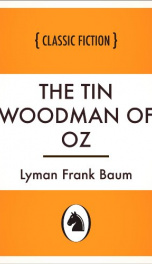
The Tin Woodman of Oz
Series:
Unknown
Year:
Unknown
Raiting:
1/5
The twelfth book of a famous Oz series by Lyman Frank Baum, a prolific American author of children's books. In "The Tin Woodman of Oz", the hero finally sets out to find his lost love, Nimmie Amee, but discovers that she has already married a man constructed partly out of his own discarded limbs.
Show more
add to favoritesadd In favorites
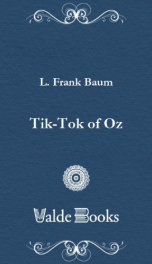
Tik-Tok of Oz
Series:
Unknown
Year:
Unknown
Raiting:
4/5
This is one of the Oz stories, one of the most remarkable and intersting among them. The plot of the story is in many ways similar to "Ozma of Oz". Here we meet a girl and an animal who find themselves in a fairyland and there meet a person named Tik-Tok and get engaged into the fight with a ruler of the Nomes. The book is full of adventures with different characters and wonderful creatures. We meet the heroes whom we already know from the early books and the new characters like Tititi-Hoochoo and Quox the Dragon who are quite amusing. The story will make you smile in many scenes and in the final chapters you will be constantly bursting with laughter.
Show more
add to favoritesadd In favorites

The Surprising Adventures of the Magical Monarch of Mo and His People
Series:
Unknown
Year:
Unknown
Raiting:
4.5/5
Adventures in a land even stranger than Oz. Best Baum not in Oz series. 118 illus. --This text refers to an alternate Paperback edition.
Show more
add to favoritesadd In favorites
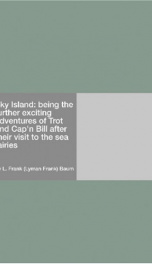
Sky Island: being the further exciting adventures of Trot and Cap'n Bill after their visit to the sea fairies
Series:
Unknown
Year:
Unknown
Raiting:
1/5
Sky Island, a children's fantasy novel written by L. Frank Baum is a sequel to The Sea Fairies of 1911. Here the young readers will meat two characters of the famous Baum’s series of Oz books: Button Bright and Polychrome, introduced in the fifth book, The Road to Oz. This is a captivating tale of a little girl named Trot and Cap'n Bill, who, carried by a magic umbrella, find themselves on a mysterious island in the sky. The children, fascinated by “The Wonderful wizard of Oz” and its sequels, as well as those who are just discovering the magic world of author’s imagination, will love to meet six snub-nosed princesses, discover the King's treasure chamber, and meet Tourmaline the poverty Queen, following the adventures of Baum’s heroes.
Show more
add to favoritesadd In favorites

Sky Island
Series:
Unknown
Year:
Unknown
Raiting:
1/5
This book was converted from its physical edition to the digital format by a community of volunteers. You may find it for free on the web. Purchase of the Kindle edition includes wireless delivery.
Show more
add to favoritesadd In favorites

The Sea Fairies
Series:
Unknown
Year:
Unknown
Raiting:
4/5
A little girl Trot from California gets into the wonderful and mysterious world of mermaid. These benevolent fairies turn her into the water-nymph, so as to follow them to the amazing land of Queen Aquarine and King Anko.
An underwater fantasy by L. Frank Baum, an American writer, poet, playwright, actor, and independent filmmaker, best known for his timeless series of Land of Oz.
Show more
add to favoritesadd In favorites
An underwater fantasy by L. Frank Baum, an American writer, poet, playwright, actor, and independent filmmaker, best known for his timeless series of Land of Oz.
Show more

The Scarecrow of Oz
Series:
Unknown
Year:
Unknown
Raiting:
4/5
A little girl named Trot and a sailor with a wooden peg-leg Cap'n Bill find themselves in Jinxland, where they help Pon, the gardener's assistant, break the spell that turned his true love's heart to ice.
The ninth of 16 Oz books by Lyman Frank Baum (1856 -1919) an American writer, poet, playwright, actor, and independent filmmaker, best known today as the author of a famous Oz series.
Show more
add to favoritesadd In favorites
The ninth of 16 Oz books by Lyman Frank Baum (1856 -1919) an American writer, poet, playwright, actor, and independent filmmaker, best known today as the author of a famous Oz series.
Show more
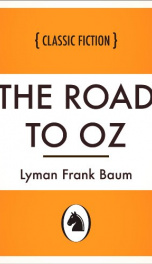
The Road to Oz
Series:
Unknown
Year:
Unknown
Raiting:
1/5
The Road to Oz is one of the Land of Oz books (the fifth one of sixteen) by L. Frank Baum. Published first in 1909, it continued to tell of the Dorothy's adventures in a wonderful fairy land.
Dorothy with her little Toto set off to Oz for the forth time, meeting numerous amusing characters, new and already known to the young readers: Shaggy man and Button Bright, Polychrome the Rainbow's Daughter, Musiker, princess Ozma and Tick-Tock, Tin Woodman, the Scarecrow, and Jack Pumpkinhead. The book will present a pleasant journey along various countries of Oz that Dorothy and her companions travel through on their way to the Emerald City.
Show more
add to favoritesadd In favorites
Dorothy with her little Toto set off to Oz for the forth time, meeting numerous amusing characters, new and already known to the young readers: Shaggy man and Button Bright, Polychrome the Rainbow's Daughter, Musiker, princess Ozma and Tick-Tock, Tin Woodman, the Scarecrow, and Jack Pumpkinhead. The book will present a pleasant journey along various countries of Oz that Dorothy and her companions travel through on their way to the Emerald City.
Show more
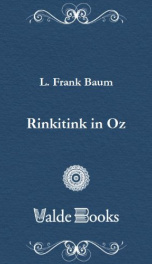
Rinkitink in Oz
Series:
Unknown
Year:
Unknown
Raiting:
4.5/5
The inhabitants of Pingaree are kidnapped by the mongrel hordes of twin island kingdoms, Prince Inga and his friend King Rinkitink proceed to the save them. One of the “Oz” books by L. F. Baum, famous American author, poet, playwright, actor, and filmmaker, tells us about the adventures of Rinkitink, Prince Inga, and Bilbil in a fantastic fairyland. The plot is tight and exciting, the dangers and charm come side by side, making an unforgettable reading for the young audience.
Show more
add to favoritesadd In favorites
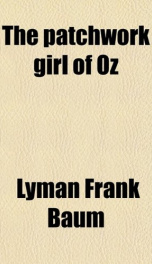
The Patchwork Girl of Oz
Series:
Unknown
Year:
Unknown
Raiting:
4.5/5
A patchwork girl, a glass cat and a boy’s adventure, where they are looking for the ingredients for a charm which will turn some people into marble. “The Patchwork Girl of Oz”, one of the famous Oz series by Lyman Frank Baum, has captivated readers for over eighty years. Learn about the adventures of a charming company of characters accompanied by Dorothy and the Scarecrow to travel to the fairy Land of Oz. A living girl made out of patchwork quilts, a boastful Glass Cat, and the charming block-headed Woozy will make children’s imagination run free.
Show more
add to favoritesadd In favorites
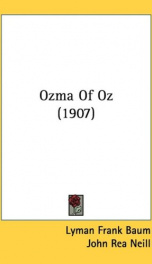
Ozma of Oz
Series:
Unknown
Year:
Unknown
Raiting:
4.5/5
Lyman Frank Baum (1856 -1919), an American author, actor, and filmmaker, created a wonderful fairyland, described in his “The Wonderful Wizard of Oz” and thirteen sequels.
This story begins with a storm, which carries Dorothy away from the steamship nobody knows where. She reaches land and finds herself in the fairy realm of Ev. Along with a talking chicken and with the help of her old friends – the Scarecrow, the Tin Woodman, the Cowardly Lion, and Ozma of Oz - Dorothy tries to rescue Queen Ev and her ten children from the King Nome.
The beloved children’s classic, delightful and comic, is an unforgettable reading for the young audience.
Show more
add to favoritesadd In favorites
This story begins with a storm, which carries Dorothy away from the steamship nobody knows where. She reaches land and finds herself in the fairy realm of Ev. Along with a talking chicken and with the help of her old friends – the Scarecrow, the Tin Woodman, the Cowardly Lion, and Ozma of Oz - Dorothy tries to rescue Queen Ev and her ten children from the King Nome.
The beloved children’s classic, delightful and comic, is an unforgettable reading for the young audience.
Show more

Mother Goose in Prose
Series:
Unknown
Year:
Unknown
Raiting:
2/5
Published three years before the author achieved fame as the creator of The Wonderful Wizard of Oz, this engaging volume, inspired by well-known nursery rhymes, added an exciting new dimension to old, much-loved verses. In 22 captivating fantasies, Baum tells about Old King Cole; The Man in the Moon; The Jolly Miller; Little Bo-Peep; Tom, the Piper's Son; The Woman Who Lived in a Shoe; Little Miss Muffet; The Cat and the Fiddle, and others. Twelve charming drawings by famed illustrator Maxfield Parrish enhance a unique collection that will delight Baum admirers, youngsters, and the young at heart. Unabridged reprint of the classic 1901 edition. 12 black-and-white illustrations. --This text refers to an alternate Paperback edition.
Show more
add to favoritesadd In favorites

The Master Key, an Electrical Fairy Tale Founded Upon the Mysteries of Electricity
Series:
Unknown
Year:
Unknown
Raiting:
1/5
This book was converted from its physical edition to the digital format by a community of volunteers. You may find it for free on the web. Purchase of the Kindle edition includes wireless delivery.
Show more
add to favoritesadd In favorites
What readers are saying
What do you think? Write your own comment on this author!
write a commentif you like Baum Lyman Frank try:

Anne Rice
(Author)

Carolyn MacCull
(Author)

Richelle Mead
(Author)

Nora Roberts
(Author)

Chloe Neill
(Author)

Ibbotson Eva
(Author)

Marie Harte
(Author)

Sunny
(Author)

Kailin Gow
(Author)

Charlaine Harris
(Author)

MaryJanice Davidson
(Author)

Sophie Jordan
(Author)

Yvonne Navarro
(Author)

Galenorn, Yasmine
(Author)

Lucy Monroe
(Author)

J.R. Ward
(Author)

Meg Cabot
(Author)

Jenna Black
(Author)

Jackson Pearce
(Author)

Heather Davis
(Author)

Shelly Laurenston
(Author)
readers also enjoyed
What readers are saying
What do you think? Write your own comment on this author!
write a commentif you like Baum Lyman Frank try:
readers also enjoyed
Do you want to exchange books? It’s EASY!
Get registered and find other users who want to give their favourite books to good hands!


